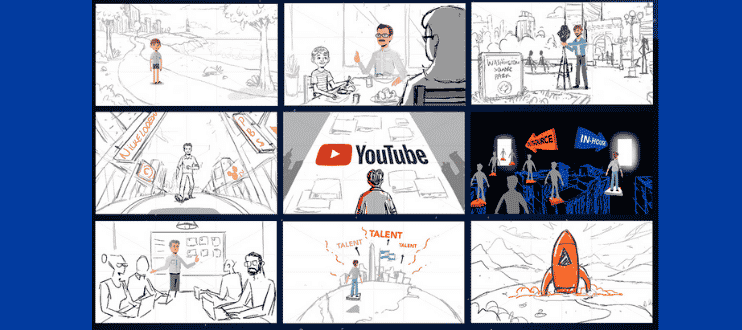It might be time to rethink video storytelling. In the modern age of instant entertainment and internet at our fingertips, the old models no longer work as advertised. Today, you have just seconds to capture viewer attention. Then, it’s an uphill battle against the ogres of distraction and disinterest to get to the peak that is your message.
A slow buildup just isn’t going to get you the results you want. If you’re running a video ad viewers will click the skip button or leave the page. On organic social media, they’ll swipe or scroll away. Worse, the algorithm will remember and make sure you never even reach their screens in the future.
To be the hero of your own marketing strategy story, you need to learn some new tricks. Fortunately, every hero gets a guide. We’ll show you how to rethink and restructure brand videos for maximum results.
The Elements of Video Storytelling
You already know that story is the core of any compelling video. It’s what captures viewer attention and keeps them emotionally invested in your message. Whether you’re selling homeowner’s insurance or training employees in new software, a story helps launch your message into orbit.
Storytelling is an art. Everyone has opinions about what counts as a basic element of story. We tend to include these five things:
- Character
- Setting
- Plot
- Conflict
- Message (theme)
You’ll find all the elements of story in this animated video we created for Georgia 811. It could have just been a traditional PSA. Instead, we framed their message as a story.
Every video you make needs interesting characters and a conflict for them to overcome. The message should be clear and the setting recognizable. Bonus points if you can offer high quality video production.
According to every storytelling guide you’ve ever seen, storytelling success comes from mixing up these ingredients in the right proportions. Yet your video ad results aren’t as strong as you’d like them to be. What’s going on?
How to Restructure Video Storytelling
To answer that question, we need to go back to basics. A story has three parts: beginning, middle, and end. Those are pretty vague labels, so let’s make them clearer. Think of these as the background, the conflict, and the resolution.
In traditional storytelling, you’d start with the background. Then you’d complicate matters with the conflict. Finally, you’d tie it all up in the resolution. Video storytelling needs a slightly different approach, especially if you’re using it for advertising.
To make sure you grab and keep audience attention, start in the middle, with the conflict. You could pose it as a question or state it as a fact. Take advantage of visual storytelling and turn it into an arresting image, like a brick wall suddenly building itself in someone’s study.
Once your viewer is invested in the conflict, then you can give them the background details. Of course, by the end, you need to present a solution. That’s likely to be your product or service.
So while traditional stories look like this: Background → Conflict → Resolution
Video storytelling for ads looks like this: Conflict → Background → Resolution
This shift can make a big difference to your watch rates. Note that this style of storytelling is popping up in all kinds of places. TV shows do it to grab your attention before the commercial break.
Think of a police procedural or detective show. What happens in the first few minutes? Someone going about their everyday life stumbles upon a corpse in an unexpected place. That’s the conflict front and center.
Books sometimes also start in the middle of the action to hook readers who are using the Look Inside function on Amazon or skimming the first pages in a bookstore.
Think back to the Georgia 811 spot. The crisis begins in the first two seconds of the story, and it is life-threatening for our Groundhog.
Consumers of media are coming to expect this style of storytelling. They may not have patience for a more traditional story structure, especially when they watch video.
Create for Your Platform and Format
You can use this conflict first strategy on any platform and in any format. But it’s particularly effective when telling a visual story for advertising.
When someone sits down to watch a movie, they’re ready and willing to invest hours into the story they’ve chosen. When an ad interrupts that movie, you’d better give them a good reason not to get up and refill their popcorn.
Starting ads in the middle makes sure the most interesting information appears first. If you’re lucky (and you’ve targeted your ads well) you’ll hold the audience’s attention long enough to deliver your message.
On YouTube, viewers can skip some pre-roll ads after five seconds. If you’re creating video advertising for YouTube, you’d better snag their attention in that time.
For platforms like TikTok or Instagram Reels, you might need to work even faster. Viewers are likely to be watching on mobile devices and can simply keep swiping if your content isn’t immediately engaging.
Non-skippable ads on TV, streaming services, and YouTube may give you a little more breathing room. But don’t get complacent. It’s still a good idea to turn your story structure inside out. Viewers may not be able to skip ads, but they can pick up their phones or take a bathroom break during the commercial.
You can snag attention by:
- Opening with an arresting or surprising visual
- Putting your character in a dangerous or strange situation
- Showing your value immediately
- Asking an interesting question
- Jumping into the conflict
If possible, try to sneak your logo and brand colors into those first few seconds. Even if they don’t watch the whole thing, you can at least boost brand awareness. But don’t make it obtrusive. If viewers won’t sit through the background to get to the conflict, they’re certainly not going to tolerate a splash screen.
Recap: Best Practices for Video Storytelling
To make video content that converts, try using all three of these best practices
- Start with the conflict
- Grab attention in 5-seconds or less
- Include all the elements of story
Of course, some of the old advice still applies. Quality audio, strong character design, and a clear and compelling message always help videos succeed.
To create video that reaches your target audience, contact the video storytelling experts at IdeaRocket. From animation to live action, we know how to use video to tell a story.



